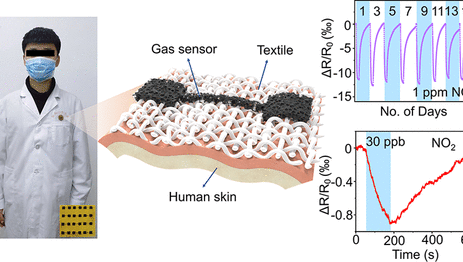Newly developed flexible, porous and highly sensitive nitrogen dioxide sensors that can be applied to skin and clothing were presented by researchers
Newly developed flexible, porous and highly sensitive nitrogen dioxide sensors that can be applied to skin and clothing have potential applications in health care, environmental health monitoring and military use, according to researchers.
Led by Huanyu “Larry” Cheng, assistant professor of engineering science and mechanics at Penn State, the researchers published their sensor designs, which build on previous models, and results in ACS Applied Materials and Interfaces.
The sensors monitor nitrogen dioxide, either from breath if attached under the nose, or from perspiration, if attached elsewhere on the body. Unlike taking blood samples, the direct skin attachment allows for continuous, long-term monitoring of the gas.
Cheng explained that while similar sensors exist, a key differentiator of the new design is breathability.
“The commonly used substrate materials for gas sensors are flexible, but not porous,” he said. “The accumulation of water moisture from the skin surface can potentially lead to irritation or damage to the skin surface. We need to make sure the device can be porous so that moisture can go through the sensor without accumulation on the surface.”
The researchers created the new sensors using a fabrication method known as laser direct writing.
“Laser direct writing is similar to additive manufacturing in that it is easy to set up and low cost, and the laser is widely available,” Cheng said. “The process is relatively robust, rapid and could be scaled up to large-scale manufacturing production.”
Cheng and his team integrated a type of material known as block copolymers with resin to laser write sensors with the desired breathability.
“Block copolymer integration goes beyond the materials we have been using, so we explored extending the substrate material from the typical thin film to virtually anything,” Cheng said. “That can give us breathability and tunability of the pore size.”
Cheng said that the sensor could monitor conditions such as chronic obstructive pulmonary disease, which nitrogen dioxide can cause or make worse. He also noted that while the sensors were developed specifically to detect nitrogen dioxide, they could potentially detect a variety of gases and biomarkers — to determine glucose levels to monitor diabetes, for example, or to identify hazards in industrial or combat settings.
“The sensors can also be useful for monitoring gas in the environment,” he said. “We could monitor air quality and inform patients of potential concerns about too much exhaust from cars, for example. Then, they could use that information to avoid certain areas on certain days.”
